Research Overview on the Electromigration Reliability of SnBi Solder Alloy
Abstract
1. Introduction
2. Electromigration Theory
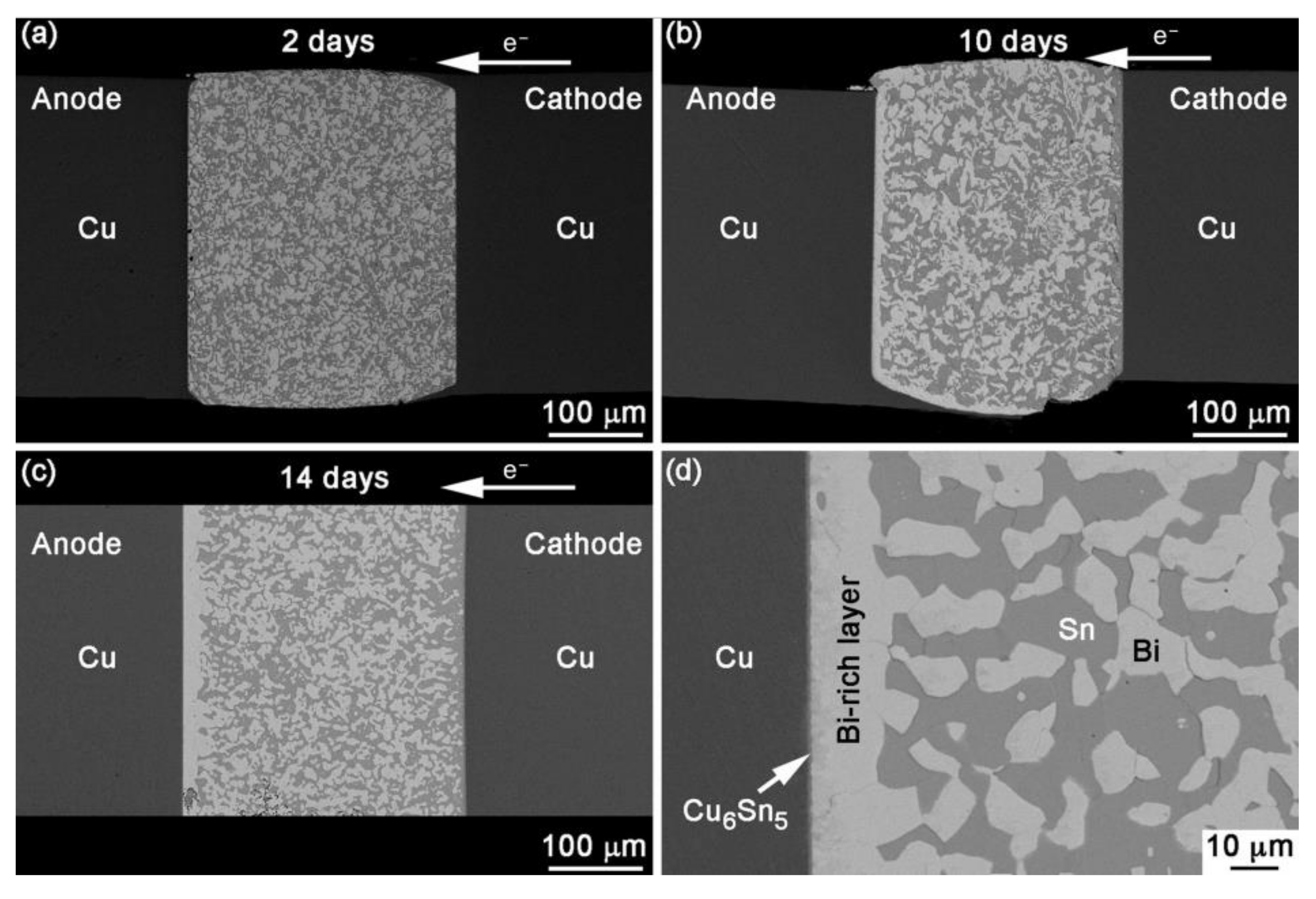
3. Defects Induced by Electromigration of SnBi Alloy on Cu Matrix
3.1. General Electromigration Behavior of SnBi Alloy Concerning Its Crystal Structure
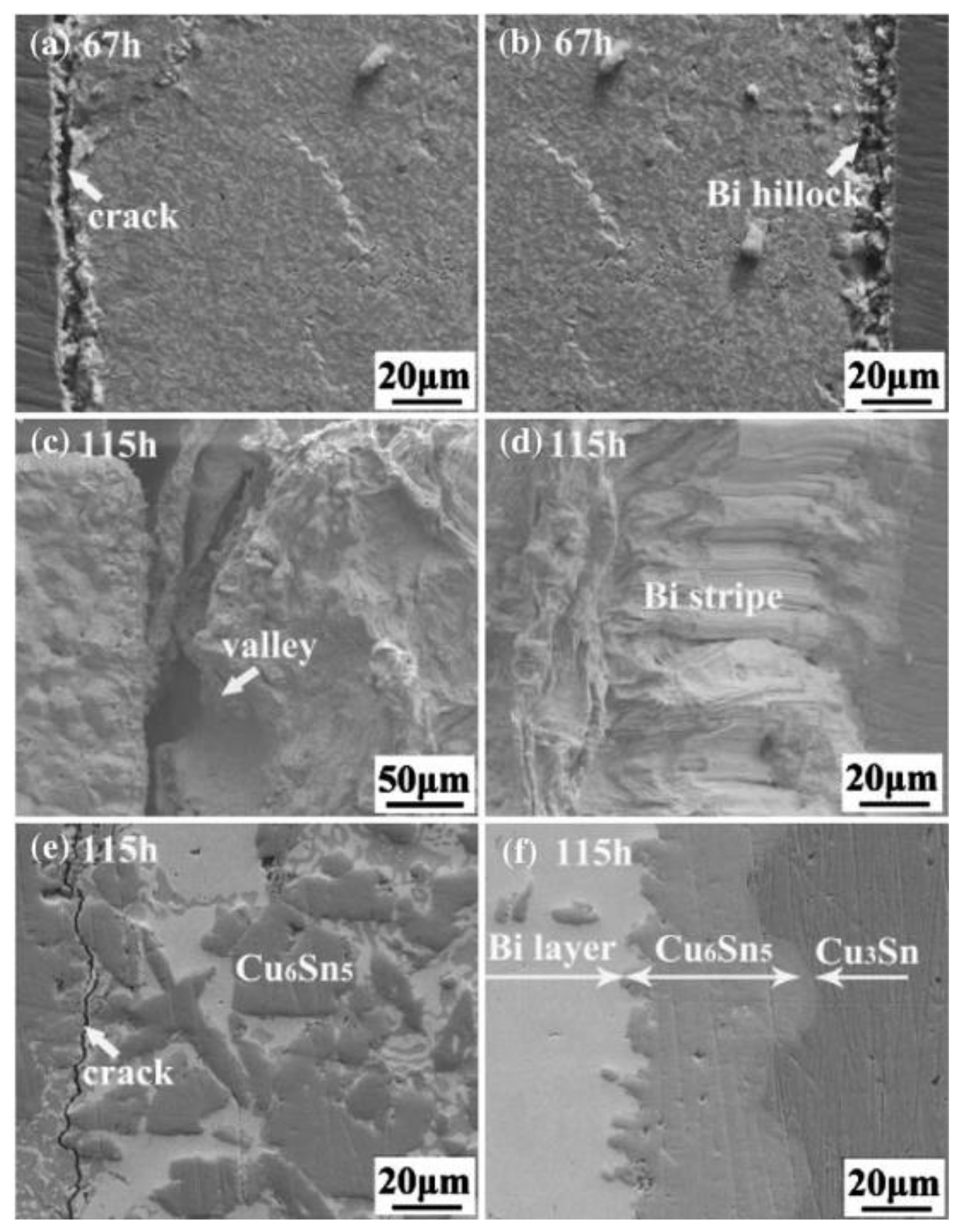
3.2. Electromigration-Induced Crack Formation
3.3. Phase Separation Phenomenon Caused by Electromigration
3.4. Effect of Electromigration on Resistance
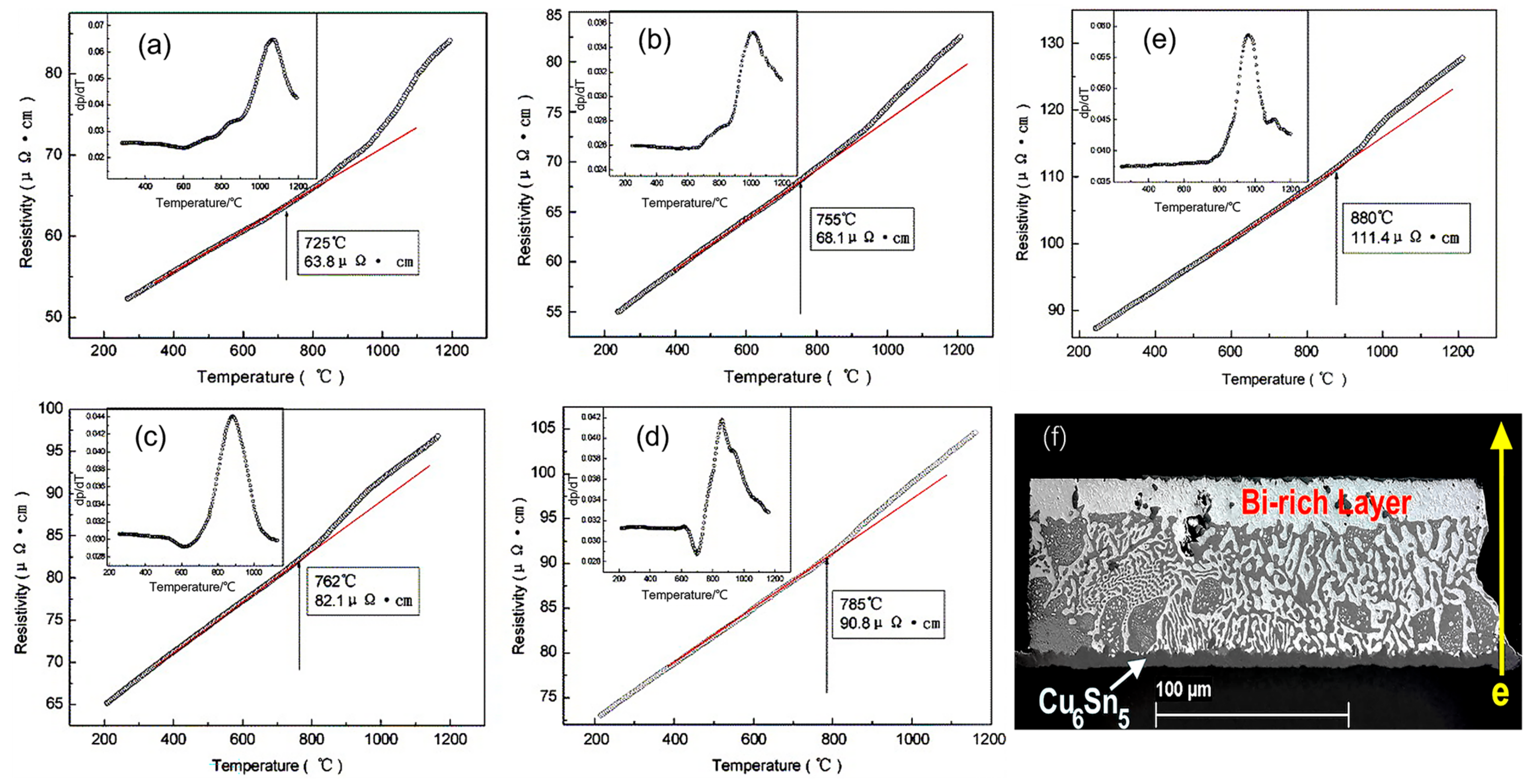
4. Methods and Measures of Electromigration Mitigation for SnBi Alloy on Cu Substrate
4.1. Addition of Alloying Element into SnBi Solder
4.1.1. Effect of Fe Addition on the Properties of the Solder
4.1.2. Effect of Ni Addition on the Properties of the Solder
4.1.3. Effect of Ag Addition on the Properties of the Solder

4.1.4. T Effect of Zn Addition on the Properties of the Solder
4.1.5. Effect of Co Addition on the Properties of the Solder
4.1.6. Effect of RE Element Addition on the Properties of the Solder
4.2. Addition of Inorganic Filler into SnBi Solder
4.2.1. Effect of Graphene Nanosheet Addition on the Properties of the Solder
4.2.2. Effect of Fullerene Addition on the Properties of the Solder
4.2.3. Effect of Al2O3 Addition on the Properties of the Solder
4.3. Other Improvement Options
5. Discussion on the Mitigation Effects of Electromigration among Different Methods and Measures
6. Conclusions
- Adding metal elements to form intermetallic compound in SnBi solders can effectively alleviate the phenomenon of atomic migration during electromigration. Metals that can form compounds with the solder or the substrate are first considered. These compounds can effectively resist atomic migration. Fe and Sn form FeSn2, which is dispersed in the solder and Cu6Sn5 layer to hinder electromigration. This compound prevents the problem of excessive growth at high temperatures after electromigration. Ni and Sn can form intermetallic compounds such as (Ni1−xCux)3Sn4, Ni7Sn2Bi, NiBi, and NiBi3. Ni atoms replace Cu atoms in Cu6Sn5 to form (Cu,Ni)6Sn5, which is more stable than Cu6Sn5. Therefore, it can alleviate the defects caused by electromigration. Ag forms Ag3Sn in the solder and has unparalleled stability under all soldering conditions. During solid-state diffusion, concentration gradients and high temperatures induce interactions between the solder joint and the Cu substrate. This compound completely changes the structure of the solder joint after electromigration. Co in the solder also forms compounds that inhibit electromigration. It should be noted that the mechanism by which Zn enhances reliability in the solder joint is different from that of other metal elements. Zn itself undergoes reverse migration, thereby hindering atomic migration.
- Adding rare earth materials and inorganic filler materials to SnBi solders can improve the reliability of solder joints based on their own properties. Adding rare earth materials to SnBi can refine the grain size and gather at the grain boundary to inhibit slip or climb of dislocations, reducing defects. Graphene nanosheets and fullerenes have unique characteristics that enhance reliability. Graphene nanosheets have a high melting point and form rigid barriers to prevent atomic migration. Fullerenes, while not having a high melting point, can alter the chemical composition within the solder, thereby impeding the generation of Kirkendall voids. As a non-conductive material, Al2O3 can be added to the SnBi solder, which can reduce the atomic flux during electromigration. The diffusion coefficients of elements in the solder are reduced. At the same time, Al2O3 particles act as barriers to hinder atomic diffusion and further suppress the growth of the Cu6Sn5 layer.
- Without adding other substances, stress engineering can be considered from the aspects of crystal orientation and pre-strain before current flow. When the crystal orientation and current direction form a certain angle, a portion of the electron wind will deflect the crystal. A critical θ angle exists between the c-axis of the crystal and the current direction. When the angle between the current and crystal orientation is lower than θ angle, the atomic migration and defect density caused by electromigration will increase rapidly. Dislocations induced by plastic pre-strain play the role of vacancy sinks in the early stage of electromigration. However, with the accumulation of vacancies at dislocation sites, the climbing of these dislocations promotes the recovery of deformation samples under current stress, greatly reducing the dislocation and vacancy density in the solder, resulting in slower diffusion of Bi atoms.
Author Contributions
Funding
Institutional Review Board Statement
Informed Consent Statement
Conflicts of Interest
References
- Hua, F.; Mei, Z.; Glazer, J. Eutectic Sn-Bi as an alternative to Pb-free solders. In Proceedings of the IEEE Instrumentation and Components and Technology Conference, Seattle, WA, USA, 25–28 May 1998; pp. 277–283. [Google Scholar]
- Wang, F.; Chen, H.; Huang, Y.; Liu, L.; Zhang, Z. Recent progress on the development of Sn–Bi based low-temperature Pb-free solders. J. Mater. Sci. Mater. Electron. 2019, 30, 3222–3243. [Google Scholar] [CrossRef]
- Hou, X.; Zhu, Y.; Yao, Q.; Song, J.; Wang, C.; Zhou, Y.; Zeng, S.; Yang, J.; Qian, Y. Phase-separated bimetal enhanced sodium storage: Dimer-like Sn-Bi@ C heterostructures with high capacity and long cycle life. J. Energy Chem. 2023, 79, 468–476. [Google Scholar] [CrossRef]
- Jiang, N.; Zhang, L.; Gao, L.L.; Song, X.G.; He, P. Recent advances on SnBi low-temperature solder for electronic interconnections. J. Mater. Sci. Mater. Electron. 2021, 32, 22731–22759. [Google Scholar] [CrossRef]
- Zhang, P.; Xue, S.; Wang, J. New challenges of miniaturization of electronic devices: Electromigration and thermomigration in lead-free solder joints. Mater. Des. 2020, 192, 108726. [Google Scholar] [CrossRef]
- Lakshminarayanan, V.; Sriraam, N. The effect of temperature on the reliability of electronic components. In Proceedings of the IEEE Instrumentation and Electronics, Computing and Communication Technologies (CONECCT), Bangalore, India, 6–7 January 2014; pp. 1–6. [Google Scholar]
- Wang, J.; Wen, L.; Zhou, J.; Chung, M. Mechanical properties and joint reliability improvement of Sn-Bi alloy. In Proceedings of the 2011 IEEE 13th Electronics Packaging Technology Conference, Singapore, 7–9 December 2011; pp. 492–496. [Google Scholar]
- Chen, C.M.; Huang, C.C. Atomic migration in eutectic SnBi solder alloys due to current stressing. J. Mater. Res. 2008, 23, 1051–1056. [Google Scholar] [CrossRef]
- Wu, B.Y.; Alam, M.O.; Chan, Y.C.; Zhong, H.W. Joule heating enhanced phase coarsening in Sn37Pb and Sn3.5Ag0.5Cu solder joints during current stressing. J. Electron. Mater. 2008, 37, 469–476. [Google Scholar] [CrossRef]
- Gu, X.; Chan, Y.C. September. Microstructural evolution by electromigration in line-type Cu/SnBi/Cu solder joint. In Proceedings of the 2008 2nd Electronics System-Integration Technology Conference, Greenwich, UK, 1–4 September 2008; pp. 885–890. [Google Scholar]
- Feng, D.; Wang, F.; Li, D.; Wu, B.; Liu, L. Atomic migration on Cu in Sn-58Bi solder from the interaction between electromigration and thermomigration. Mater. Res. Express 2019, 6, 046301. [Google Scholar] [CrossRef]
- Wang, F.; Liu, L.; Li, D.; Wu, M. Electromigration behaviors in Sn–58Bi solder joints under different current densities and temperatures. J. Mater. Sci. Mater. Electron. 2018, 29, 21157–21169. [Google Scholar] [CrossRef]
- Qin, H.B.; Yue, W.; Ke, C.B.; Zhou, M.B.; Zhang, X.P.; Li, B. Interaction effect between electromigration and microstructure evolution in BGA structure Cu/Sn-58Bi/Cu solder interconnects. In Proceedings of the 2014 15th International Conference on Electronic Packaging Technology, Chengdu, China, 12–15 August 2014; pp. 587–591. [Google Scholar]
- Liang, S.B.; Ke, C.B.; Wei, C.; Huang, J.Q.; Zhou, M.B.; Zhang, X.P. Microstructural evolution and change in macroscopic physical properties of microscale flip chip Cu/Sn58Bi/Cu joints under the coupling effect of electric current stressing and elastic stress. J. Mater. Res. 2019, 34, 2775–2788. [Google Scholar] [CrossRef]
- Shang, P.J.; Liu, Z.Q.; Li, D.X.; Shang, J.K. TEM observations of the growth of intermetallic compounds at the SnBi/Cu interface. J. Electron. Mater. 2009, 38, 2579–2584. [Google Scholar] [CrossRef]
- Zhang, L.; Ou, S.; Huang, J.; Tu, K.N.; Gee, S.; Nguyen, L. Effect of current crowding on void propagation at the interface between intermetallic compound and solder in flip chip solder joints. Appl. Phys. Lett. 2006, 88, 012106. [Google Scholar] [CrossRef]
- Chen, C.M.; Chen, L.T.; Lin, Y.S. Electromigration-induced Bi segregation in eutectic SnBi solder joint. J. Electron. Mater. 2007, 36, 168–172. [Google Scholar] [CrossRef]
- Zhou, W.; Liu, L.; Li, B.; Wu, P. Fast mass migration in SnBi deposits enhanced by electric current. Thin Solid Films 2010, 518, 5875–5880. [Google Scholar] [CrossRef]
- Guo, F.; Xu, G.; He, H.; Zhao, M.; Sun, J.; Wang, C.H. Effect of electromigration and isothermal aging on the formation of metal whiskers and hillocks in eutectic Sn-Bi solder joints and reaction films. J. Electron. Mater. 2009, 38, 2647–2658. [Google Scholar] [CrossRef]
- Tian, S.; Cao, R.; Fan, Q.; Zhou, X.; Jia, Y.; Zhou, J.; Sun, Z. Mitigation of whisker growth by improving the creep properties of Sn coating with bismuth. J. Mater. Sci. 2021, 56, 17131–17145. [Google Scholar] [CrossRef]
- Wu, Y.U.E.; Qin, H.B.; Zhou, M.B.; Zhang, X.P. Electromigration induced microstructure evolution and damage in asymmetric Cu/Sn-58Bi/Cu solder interconnect under current stressing. Trans. Nonferrous Met. Soc. China 2014, 24, 1619–1628. [Google Scholar]
- Zhao, X.; Muraoka, M.; Saka, M. Length-dependent electromigration behavior of Sn58Bi solder and critical length of electromigration. J. Electron. Mater. 2017, 46, 1287–1292. [Google Scholar] [CrossRef]
- Zuo, Y.; Ma, L.; Liu, S.; Shu, Y.; Guo, F. Evolution of microstructure across eutectic Sn-Bi solder joints under simultaneous thermal cycling and current stressing. J. Electron. Mater. 2015, 44, 597–603. [Google Scholar] [CrossRef]
- He, H.; Xu, G.; Guo, F. Electromigration-induced Bi-rich whisker growth in Cu/Sn–58Bi/Cu solder joints. J. Mater. Sci. 2010, 45, 334–340. [Google Scholar] [CrossRef]
- Chan, Y.C.; Yang, D. Failure mechanisms of solder interconnects under current stressing in advanced electronic packages. Prog. Mater. Sci. 2010, 55, 428–475. [Google Scholar] [CrossRef]
- Huang, J.R.; Tsai, C.M.; Lin, Y.W.; Kao, C.R. Pronounced electromigration of Cu in molten Sn-based solders. J. Mater. Res. 2008, 23, 250–257. [Google Scholar] [CrossRef]
- Shang, P.J.; Liu, Z.Q.; Li, D.X.; Shang, J.K. Bi-induced voids at the Cu3Sn/Cu interface in eutectic SnBi/Cu solder joints. Scripta Mater. 2008, 58, 409–412. [Google Scholar] [CrossRef]
- Chuang, T.H.; Cheng, C.Y.; Chang, T.C. Evaluations of Whisker Growth and Fatigue Reliability of Sn-3Ag-0.5 Cu and Sn-3Ag-0.5 Cu-0.05 Ce Solder Ball Grid Array Packages. J. Electron. Mater. 2009, 38, 2762–2769. [Google Scholar] [CrossRef]
- Lee, A.; Liu, W.; Ho, C.E.; Subramanian, K.N. Synchrotron X-ray microscopy studies on electromigration of a two-phase material. J. Appl. Phys. 2007, 102, 1203. [Google Scholar] [CrossRef]
- Zhao, X.; Saka, M.; Muraoka, M.; Yamashita, M.; Hokazono, H. Electromigration behaviors and effects of addition elements on the formation of a Bi-rich layer in Sn58Bi-based solders. J. Electron. Mater. 2014, 43, 4179–4185. [Google Scholar] [CrossRef]
- Liu, Y.; Xue, Y.; Zhou, M.; Cao, R.; Zeng, X.; Li, H.; Zhang, S. Effects of Sn-Ag-x leveling layers on the microstructure and mechanical properties of SnBi low-temperature solder joints. Solder. Surf. Mt. Technol. 2022, 34, 153–161. [Google Scholar] [CrossRef]
- He, H.; Xu, G.; Guo, F. Effect of small amount of rare earth addition on electromigration in eutectic SnBi solder reaction couple. J. Mater. Sci. 2009, 44, 2089–2096. [Google Scholar] [CrossRef]
- Zou, H.F.; Zhang, Q.K.; Zhang, Z.F. Eliminating interfacial segregation and embrittlement of bismuth in SnBi/Cu joint by alloying Cu substrate. Scr. Mater. 2009, 61, 308–311. [Google Scholar] [CrossRef]
- Liu, Q.; Shu, Y.; Ma, L.; Guo, F. Study of microstructure evolution and temperature distribution in eutectic SnBi solder joints under high current density. In Proceedings of the 2014 15th International Conference on Electronic Packaging Technology, Chengdu, China, 12–15 August 2014; pp. 907–911. [Google Scholar]
- Liang, S.B.; Ke, C.B.; Ma, W.J.; Zhou, M.B.; Zhang, X.P. Phase field simulation of segregation of the Bi-riched phase in Cu/Sn-Bi/Cu solder interconnects under electric current stressing. In Proceedings of the 2016 IEEE 66th Electronic Components and Technology Conference (ECTC), Las Vegas, NV, USA, 31 May–3 June 2016; pp. 264–270. [Google Scholar]
- Hadian, F.; Panta, S.; Flores, J.; Cotts, E.J. The failure of Sn-Bi-based solder joints due to current stressing. J. Electron. Mater. 2023, 52, 751–759. [Google Scholar] [CrossRef]
- Li, X.; Wang, J.; Qin, H.; He, S.; Li, W.; Wei, S. Creep performance of phase-inhomogeneous Cu/Sn–58Bi/Cu solder joints with increasing current density. J. Mater. Sci. Mater. Electron. 2022, 33, 16167–16182. [Google Scholar] [CrossRef]
- Yang, Q.L.; Shang, J.K. Interfacial segregation of Bi during current stressing of Sn-Bi/Cu solder interconnect. J. Electron. Mater. 2005, 34, 1363–1367. [Google Scholar] [CrossRef]
- Bashir, M.N.; Haseeb, A.S.M.A.; Rahman, A.Z.M.S.; Fazal, M.A.; Kao, C.R. Reduction of electromigration damage in SAC305 solder joints by adding Ni nanoparticles through flux do. J. Mater. Sci. 2015, 50, 6748–6756. [Google Scholar] [CrossRef]
- Skwarek, A.; Illés, B.; Witek, K.; Hurtony, T.; Tarasiuk, J.; Wronski, S.; Synkiewicz, B.K. Reliability studies of InnoLot and SnBi joints soldered on DBC substrate. Solder. Surf. Mt. Technol. 2018, 30, 205–212. [Google Scholar] [CrossRef]
- Lai, Y.Y.; Chao, J.L.; Hsu, C.J.; Wang, C.M.; Wu, A.T. Hybrid Solder Joint for Low-Temperature Bonding Application. J. Electron. Mater. 2023, 52, 782–791. [Google Scholar] [CrossRef]
- Du, C.; Wang, X.; Lai, Z. Generation of near eutectic phase layer in Sn-15Bi solder joint during electro-migration. Mater. Lett. 2017, 191, 193–195. [Google Scholar] [CrossRef]
- Wang, F.; Chen, H.; Li, D.; Zhang, Z.; Wang, X. Interfacial behaviors in Cu/molten Sn–58Bi/Cu solder joints under coupling with thermal and current stressing. Electron. Mater. Lett. 2019, 15, 36–48. [Google Scholar] [CrossRef]
- Zhang, Z.J.; Huang, M.L. Abnormal migration behavior and segregation mechanism of Bi atoms undergoing liquid–solid electromigration. J. Mater. Sci. 2019, 54, 7975–7986. [Google Scholar] [CrossRef]
- Li, X.F.; Zu, F.Q.; Ding, H.F.; Yu, J.; Liu, L.J.; Xi, Y. High-temperature liquid–liquid structure transition in liquid Sn–Bi alloys: Experimental evidence by electrical resistivity method. Phys. Lett. A 2006, 354, 325–329. [Google Scholar] [CrossRef]
- Li, M.; Geng, H.; Long, F.; Zuo, M.; Liu, R.; Lu, S. Discontinuous structural phase transition of Sn–Bi melts. J. Mol. Liq. 2015, 204, 27–32. [Google Scholar] [CrossRef]
- Zuo, Y.; Ma, L.; Liu, S.; Wang, T.; Guo, F.; Wang, X. The coupling effects of thermal cycling and high current density on Sn58Bi solder joints. J. Mater. Sci. 2013, 48, 2318–2325. [Google Scholar] [CrossRef]
- Sun, J.; Xu, G.; Guo, F.; Lei, Y.; Shi, Y.; Wang, X. Effects of electromigration on resistance changes in eutectic SnBi solder joints. J. Mater. Sci. 2011, 46, 3544–3549. [Google Scholar] [CrossRef]
- Murayama, K.; Aizawa, M.; Higashi, M. Study of electro-migration resistivity of micro bump using SnBi solder. In Proceedings of the 2014 IEEE 64th Electronic Components and Technology Conference (ECTC), Orlando, FL, USA, 27–30 May 2014; pp. 1166–1172. [Google Scholar]
- Hadian, F.; Flores, J.; Cotts, E. The variation of the electrical resistance and microstructure of SnBi based solder joints with current stressing. JOM 2022, 74, 2139–2147. [Google Scholar] [CrossRef]
- Murayama, K.; Aizawa, M.; Kurihara, T. Effects of the inter-metallic compounds microstructure on electro-migration of Sn-Bi solder system. In Proceedings of the 2017 IEEE 67th Electronic Components and Technology Conference (ECTC), Orlando, FL, USA, 30 May–2 June 2017; pp. 464–469. [Google Scholar]
- Zuo, Y.; Ma, L.; Guo, F.; Qiao, L.; Shu, Y.; Lee, A.; Subramanian, K.N. Effects of Electromigration on the Creep and Thermal Fatigue Behavior of Sn58Bi Solder Joints. J. Electron. Mater. 2014, 43, 4395–4405. [Google Scholar] [CrossRef]
- Ma, L.; Zuo, Y.; Liu, S.; Guo, F.; Wang, X. The failure models of Sn-based solder joints under coupling effects of electromigration and thermal cycling. J. Appl. Phys. 2013, 113, 044904. [Google Scholar] [CrossRef]
- Jiang, N.; Zhang, L.; Liu, Z.Q.; Sun, L.; Long, W.M.; He, P.; Xiong, M.Y.; Zhao, M. Reliability issues of lead-free solder joints in electronic devices. Sci. Technol. Adv. Mater. 2019, 20, 876–901. [Google Scholar] [CrossRef] [PubMed]
- Li, M.L.; Zhang, L.; Jiang, N.; Zhang, L.; Zhong, S.J. Materials modification of the lead-free solders incorporated with micro/nano-sized particles: A review. Mater. Des. 2021, 197, 109224. [Google Scholar] [CrossRef]
- Hsiao, Y.H.; Lin, K.L.; Lee, C.W.; Shao, Y.H.; Lai, Y.S. Study of electromigration-induced failures on Cu pillar bumps joined to OSP and ENEPIG substrates. J. Electron. Mater. 2012, 41, 3368–3374. [Google Scholar] [CrossRef]
- Li, Z.B.; Hu, D.A.; Chen, Y.P.; Cheng, D.H.; He, K.; Guo, Y.L. Effect of Fe particles on the structure and properties of SnBi/Cu joint during aging. Trans. China Weld. Inst. 2020, 41, 22–28+98. [Google Scholar]
- Mahdavifard, M.H.; Sabri, M.F.M.; Said, S.M.; Rozali, S. High stability and aging resistance Sn-1Ag-0.5Cu solder alloy by Fe and Bi minor alloying. Microelectron. Eng. 2019, 208, 29–38. [Google Scholar] [CrossRef]
- Gao, L.Y.; Li, C.F.; Wan, P.; Liu, Z.Q. A superior interfacial reliability of Fe-Ni UBM during high temperature storage. J. Mater. Sci. Mater. Electron. 2017, 28, 8537–8545. [Google Scholar] [CrossRef]
- Mandavifard, M.H.; Sabri, M.F.M.; Said, S.M.; Shnawah, D.A.; Badruddin, I.A.; Rozali, S. Effects of Fe and Bi Minor Alloying on Mechanical, Thermal, and Microstructural Properties of Sn-0.7Cu Solder Alloy. J. Electron. Mater. 2016, 45, 3673–3682. [Google Scholar] [CrossRef]
- Yang, L.; Liu, H.Y.; Wu, P.P. Effect of Fe Particle on Electromigration for SnBi Solder. Hot Work. Technol. 2016, 45, 216–218. [Google Scholar]
- Wu, W.H.; Chung, H.L.; Chen, C.N.; Ho, C.E. The Influence of Current Direction on the Cu-Ni Cross-Interaction in Cu/Sn/Ni Diffusion Couples. J. Electron. Mater. 2009, 38, 2563–2572. [Google Scholar] [CrossRef]
- Lee, S.M.; Yoon, J.W.; Jung, S.B. Electromigration effect on Sn-58% Bi solder joints with various substrate metallizations under current stress. J. Mater. Sci. Mater. Electron. 2016, 27, 1105–1112. [Google Scholar] [CrossRef]
- Gu, X.; Chan, Y.C. Thermomigration and electromigration in Sn58Bi solder joints. J. Appl. Phys. 2009, 105, 461–465. [Google Scholar] [CrossRef]
- Bashir, M.N.; Haseeb, A. Improving mechanical and electrical properties of Cu/SAC305/Cu solder joints under electromigration by using Ni nanoparticles doped flux. J. Mater. Sci. Mater. Electron. 2018, 29, 3182–3188. [Google Scholar] [CrossRef]
- Vassilev, G.P.; Lilova, K.I.; Gachon, J.C. Phase diagram investigations of the Ni–Sn–Bi system. J. Alloys Compd. 2009, 469, 264–269. [Google Scholar] [CrossRef]
- Bashir, M.N.; Haseeb, A.; Wakeel, S.; Khan, M.A.; Quazi, M.M.; Khan, N.B.; Ahmed, A.; Soudagar, M.E. Effect of Ni and Co nanoparticle-doped flux on microstructure of SAC305 solder matrix. J. Mater. Sci. Mater. Electron. 2022, 33, 20106–22020. [Google Scholar] [CrossRef]
- Chen, L.T.; Chen, C.M. Electromigration study in the eutectic SnBi solder joint on the Ni/Au metallization. J. Mater. Res. 2006, 21, 962–969. [Google Scholar] [CrossRef]
- Kuang, J.M.; Huang, M.L. Mechanism on scalloped Cu6Sn5 grain refinement under interaction of Cu and Ni. Mater. Lett. 2023, 341, 134218. [Google Scholar] [CrossRef]
- Xu, Q.G.; Liu, X.B.; Zhang, H.F. Current enhanced wettability of eutectic SnBi melt on Cu substrate. Mater. Sci. Technol. 2011, 27, 666–669. [Google Scholar] [CrossRef]
- Minho, O.; Tanaka, Y.; Kobayashi, E. Microstructure evolution at the interface between Cu and eutectic Sn–Bi alloy with the addition of Ag or Ni. J. Mater. Res. Technol. 2023, 26, 8165–8180. [Google Scholar]
- Kumar, A.; Yang, Y.; Wong, C.C.; Kripesh, V.; Chen, Z. Effect of Electromigration on the Mechanical Performance of Sn-3.5Ag Solder Joints with Ni and Ni-P Metallizations. J. Electron. Mater. 2009, 38, 78–87. [Google Scholar] [CrossRef]
- Mao, X.; Zhang, R.; Hu, X. Influence of Ni foam/Sn composite solder foil on IMC growth and mechanical properties of solder joints bonded with solid-liquid electromigration. Intermetallics 2021, 131, 107107. [Google Scholar] [CrossRef]
- Xu, G.; Guo, F.; Wang, X.; Xia, Z.; Lei, Y.; Shi, Y.; Li, X. Retarding the electromigration effects to the eutectic SnBi solder joints by micro-sized Ni-particles reinforcement approach. J. Alloys Compd. 2011, 509, 878–884. [Google Scholar] [CrossRef]
- Wang, F.; Zhou, L.; Zhang, Z.; Wang, J.; Wang, X.; Wu, M. Effect of Sn-Ag-Cu on the Improvement of Electromigration Behavior in Sn-58Bi Solder Joint. J. Electron. Mater. 2017, 46, 6204–6213. [Google Scholar] [CrossRef]
- Chen, Y.B.; Meng, Z.C.; Gao, L.Y.; Liu, Z.Q. Temperature gradient induced orientation change of Bi grains in Sn-Bi57-Ag0.7 solder joint. Acta Metall. Sin.—Eng. Lett. 2022, 35, 1184–1194. [Google Scholar] [CrossRef]
- Shen, Y.A.; Zhou, S.; Li, J.; Yang, C.; Huang, S.; Lin, S.; Nishikawa, H. Sn-3.0Ag-0.5Cu/Sn-58Bi composite solder joint assembled using a low-temperature reflow process for PoP technology. Mater. Des. 2019, 183, 108144. [Google Scholar] [CrossRef]
- Hsu, C.M.; Chen, S.W. Interfacial reactions with and without current stressing at Sn–Co/Ag and Sn–Co/Cu solder joints. J. Mater. Sci. 2013, 48, 6640–6646. [Google Scholar] [CrossRef]
- Kattner, U.R.; Boettinger, W.J. On the Sn-Bi-Ag ternary phase diagram. J. Electron. Mater. 1994, 23, 603–610. [Google Scholar] [CrossRef]
- Silva, B.L.; Garcia, A.; Spinelli, J.E. Cooling thermal parameters and microstructure features of directionally solidified ternary Sn–Bi–(Cu,Ag) solder alloys. Mater. Charact. 2016, 114, 30–42. [Google Scholar] [CrossRef]
- Ma, L.; Xu, G.; Sun, J.; Guo, F.; Wang, X. Effects of Co additions on electromigration behaviors in Sn–3.0 Ag–0.5 Cu-based solder joint. J. Mater. Sci. 2011, 46, 4896–4905. [Google Scholar] [CrossRef]
- Chen, Y.B.; Meng, Z.C.; Gao, L.Y.; Liu, Z.Q. Effect of Bi addition on the shear strength and failure mechanism of low-Ag lead-free solder joints. J. Mater. Sci. Mater. Electron. 2021, 32, 2172–2186. [Google Scholar] [CrossRef]
- Chen, C.M.; Huang, C.C. Effects of silver doping on electromigration of eutectic SnBi solder. J. Alloys Compd. 2008, 461, 235–241. [Google Scholar] [CrossRef]
- Ismathullakhan, S.; Lau, H.; Chan, Y.C. Enhanced electromigration reliability via Ag nanoparticles modified eutectic Sn–58Bi solder joint. Microsyst. Technol. 2013, 19, 1069–1080. [Google Scholar] [CrossRef]
- Shafiq, I.; Chan, Y.C. Improved electro-migration resistance in nano Ag modified Sn-58Bi solder joints under current stressing. In Proceedings of the 2011 International Conference on Quality, Reliability, Risk, Maintenance, and Safety Engineering, Xi’an, China, 17–19 June 2011; pp. 374–379. [Google Scholar]
- Yu, Z.; Zongyuan, Y.; Zhimin, L.; Ying, L.; Liwei, W.; Narayanaswamy, B. Effect of Ag and Cu co-addition on the microstructure and creep properties of Sn-5Sb solder under current stressing. Microelectron. Reliab. 2022, 139, 114807. [Google Scholar] [CrossRef]
- Liu, S.; Liu, Z.; Liu, L.; Song, T.; Liu, W.; Tan, Y.; San, Z.; Huang, S. Electromigration behavior of Cu/Sn–58Bi–1Ag/Cu solder joints by ultrasonic soldering process. J. Mater. Sci. Mater. Electron. 2020, 31, 11997–12003. [Google Scholar] [CrossRef]
- Sun, H.; Chan, Y.C.; Wu, F. Influence of the aggregated Ag3Sn on the improvement of electromigration phenomenon in the doped Sn58Bi solder joints. J. Mater. Sci. Mater. Electron. 2015, 26, 5129–5134. [Google Scholar] [CrossRef]
- Hu, F.Q.; Zhang, Q.K.; Jiang, J.J.; Song, Z.L. Influences of Ag addition to Sn-58Bi solder on SnBi/Cu interfacial reaction. Mater. Lett. 2017, 214, 142–145. [Google Scholar] [CrossRef]
- Wang, J.Y.; Lin, Y.X.; Yeh, C.Y.; Chiu, C.Y.; Lin, E.J.; Wu, C.Y.; Lee, C.H.; Chang, P.J.; Liu, C.Y. Effect of Ag solutes on the solid-state Cu dissolution in the Sn3.5Ag. J. Mater. Sci. Mater. Electron. 2021, 32, 567–576. [Google Scholar] [CrossRef]
- Ma, D.; Wu, P. Improved microstructure and mechanical properties for Sn58Bi0.7Zn solder joint by addition of graphene nanosheets. J. Alloys Compd. 2016, 671, 127–136. [Google Scholar] [CrossRef]
- Liu, L.; Zhou, W.; Zhang, H.; Li, B.; Wu, P. Electromigration behavior in Cu/Sn–8Zn–3Bi/Cu solder joint. Microelectron. Reliab. 2010, 50, 251–257. [Google Scholar] [CrossRef]
- Zhang, X.F.; Guo, J.D.; Shang, J.K. Abnormal polarity effect of electromigration on intermetallic compound formation in Sn–9Zn solder interconnect. Scr. Mater. 2007, 57, 513516. [Google Scholar] [CrossRef]
- Ma, D.-L.; Wu, P. Effects of Zn addition on mechanical properties of eutectic Sn-58Bi solder during liquid-state aging. Trans. Nonferrous Met. Soc. China 2015, 25, 1225–1233. [Google Scholar] [CrossRef]
- Wang, F.; Liu, L.; Zhou, L.; Wang, J.; Wu, M.; Wang, X. Microstructural Evolution of Sn-58Bi/Cu Joints through Minor Zn Alloying Substrate during Electromigration. Mater. Trans. 2017, 58, 1593–1600. [Google Scholar] [CrossRef]
- Bashir, M.N.; Haseeb, A.; Naher, S.; Ali, M.M.; Bashir, M.B.A.; Zaidi, A.A.; Jamshaid, M.; Javed, I. Effects of cobalt nanoparticle on microstructure of Sn58Bi solder joint. J. Mater. Sci. Mater. Electron. 2023, 34, 248. [Google Scholar] [CrossRef]
- Qiu, H.; Xu, H.; Zhang, C.; Hu, X.; Jiang, X.; Li, Q. Influence of Co addition on microstructure evolution and mechanical strength of solder joints bonded with solid–liquid electromigration. J. Mater. Sci. Mater. Electron. 2021, 32, 17336–17348. [Google Scholar] [CrossRef]
- Zhang, S.; Xu, S.; Duan, X.; Paik, K.W.; Hea, P. Effects of Co on the Morphology, Shear Strength and Fracture of the Low Temperature SAC305/Sn-58Bi/Cu Composite Solder Joint. In Proceedings of the 2021 IEEE 23rd Electronics Packaging Technology Conference (EPTC), Singapore, 7–9 December 2021; pp. 460–463. [Google Scholar]
- Dudek, M.A.; Chawla, N. Effect of Rare-Earth (La, Ce, and Y) Additions on the Microstructure and Mechanical Behavior of Sn-3.9Ag-0.7Cu Solder Alloy. Metall. Mater. Trans. A 2010, 41, 610–620. [Google Scholar] [CrossRef]
- Wu, C.M.; Yu, D.Q.; Law, C.M.; Wang, L. Properties of lead-free solder alloys with rare earth element additions. Mater. Sci. Eng. R Rep. 2004, 44, 1–44. [Google Scholar] [CrossRef]
- Hung, F.Y.; Lui, T.S.; Chen, L.H.; Lan, K.A. Microstructures and Fusing Electrical Current of Microelectronic Sn-9Zn-(0.25RE) Solders. Mater. Trans. 2008, 49, 1491–1495. [Google Scholar] [CrossRef]
- Li, Q.; Xiong, M.; Liu, F.; Wu, H.; Yue, X.; Li, L.; Gao, H.; Yi, Y. Effect of Er content on the interfacial microstructure, shear properties and creep properties of Sn58Bi joints. IOP Conf. Ser. Earth Environ. Sci. 2021, 714, 032017. [Google Scholar]
- Zeng, G.; Xue, S.; Gao, L.; Zhang, L.; Hu, Y.; Lai, Z. Interfacial microstructure and properties of Sn–0.7Cu–0.05Ni/Cu solder joint with rare earth Nd addition. J. Alloys Compd. 2011, 509, 7152–7161. [Google Scholar] [CrossRef]
- Zhao, M.; Hao, H.; Xu, G.; Sun, J.; Shi, Y.; Guo, F. Fundamental studies on whisker growth in Sn-based Solders. In Proceedings of the 2009 International Conference on Electronic Packaging Technology & High Density Packaging, Beijing, China, 10–13 August 2009; pp. 585–588. [Google Scholar]
- Liu, X.; Huang, M.; Wu, C.M.; Wang, L. Effect of YO particles on microstructure formation and shear properties of Sn-58Bi solder. J. Mater. Sci. Mater. Electron. 2010, 21, 1046–1054. [Google Scholar] [CrossRef]
- Dong, W.; Shi, Y.; Xia, Z.; Lei, Y.; Guo, F. Effects of Trace Amounts of Rare Earth Additions on Microstructure and Properties of Sn-Bi-Based Solder Alloy. J. Electron. Mater. 2008, 37, 982–991. [Google Scholar] [CrossRef]
- Cheng, S.; Huang, C.M.; Pecht, M. A review of lead-free solders for electronics applications. Microelectron. Reliab. 2017, 75, 77–95. [Google Scholar] [CrossRef]
- Li, Y.; Yu, S.; Li, L.; Song, S.; Qin, W.; Qi, D.; Yang, W.; Zhan, Y. A Review on the Development of Adding Graphene to Sn-Based Lead-Free Solder. Metals 2023, 13, 1209. [Google Scholar] [CrossRef]
- Ma, Y.; Li, X.; Zhou, W.; Yang, L.; Wu, P. Reinforcement of graphene nanosheets on the microstructure and properties of Sn58Bi lead-free solder. Mater. Des. 2017, 113, 264–272. [Google Scholar] [CrossRef]
- Liu, P.; Guo, W.; Wu, P. Effects of GNSs addition on the electromigration of Sn58Bi and Cu-core Sn58Bi joint. J. Mater. Sci. 2022, 57, 15598–15611. [Google Scholar] [CrossRef]
- Ma, Y.; Li, X.; Yang, L.; Zhou, W.; Wang, M.; Zhu, W.; Wu, P. Effects of graphene nanosheets addition on microstructure and mechanical properties of SnBi solder alloys during solid-state aging. Mater. Sci. Eng. A 2017, 696, 437–444. [Google Scholar] [CrossRef]
- Shen, Y.A.; Chen, H.Z.; Chen, S.W.; Chiu, S.K.; Guo, X.Y.; Hsieh, Y.P. Graphene as a diffusion barrier at the interface of Liquid–State low-melting Sn–58Bi alloy and copper foil. Appl. Surf. Sci. 2022, 578, 152108. [Google Scholar] [CrossRef]
- Chen, G.; Cui, X.; Wu, Y.; Li, W.; Wu, F. Performance of 96.5 Sn–3Ag–0.5 Cu/fullerene composite solder under isothermal ageing and high-current stressing. Solder. Surf. Mt. Technol. 2021, 33, 35–46. [Google Scholar] [CrossRef]
- Chen, G.; Liu, L.; Du, J.; Silberschmidt, V.V.; Chan, Y.C.; Liu, C.; Wu, F. Thermo-migration behavior of SAC305 lead-free solder reinforced with fullerene nanoparticles. J. Mater. Sci. 2016, 51, 10077–10091. [Google Scholar] [CrossRef]
- Chen, G.; Wu, F.; Liu, C.; Xia, W.; Liu, H. Effects of fullerenes reinforcement on the performance of 96.5Sn–3Ag–0.5Cu lead-free solder. Mater. Sci. Eng. A 2015, 636, 484–492. [Google Scholar] [CrossRef]
- Zhang, R.; Xu, G.; Wang, X.; Guo, F.; Lee, A.; Subramanian, K.N. Electromigration in Sn-Bi modified with polyhedral oligomeric silsesquioxane. J. Electron. Mater. 2010, 39, 2513–2521. [Google Scholar] [CrossRef]
- Ma, L.; Zuo, Y.; Liu, S.; Guo, F.; Lee, A.; Subramanian, K. Whisker growth behaviors in POSS-silanol modified Sn3.0Ag0.5Cu composite solders. J. Alloys Compd. 2016, 657, 400–407. [Google Scholar] [CrossRef]
- Hu, X.; Chan, Y.C.; Zhang, K.; Yung, K. Effect of graphene doping on microstructural and mechanical properties of Sn–8Zn–3Bi solder joints together with electromigration analysis. J. Alloys Compd. 2013, 580, 162–171. [Google Scholar] [CrossRef]
- Hu, T.; Li, Y.; Chan, Y.C.; Wu, F. Effect of nano Al2O3 particles doping on electromigration and mechanical properties of Sn–58Bi solder joints. Microelectron. Reliab. 2015, 55, 1226–1233. [Google Scholar] [CrossRef]
- Shafiq, I.; Chan, Y.C.; Xu, S.; Li, Q.Q. Electro-migration study of nano Al doped lead-free Sn-58Bi on Cu and Au/Ni/Cu ball grid array (BGA) packages. In Proceedings of the 18th European Microelectronics & Packaging Conference, Brighton, UK, 12–15 September 2011; pp. 1–7. [Google Scholar]
- Yang, L.; Ge, J.; Zhang, Y.; Dai, J.; Jing, Y. Electromigration reliability for Al2O3-reinforced Cu/Sn–58Bi/Cu composite solder joints. J. Mater. Sci. Mater. Electron. 2017, 28, 3004–3012. [Google Scholar] [CrossRef]
- Murayama, K.; Aizawa, M.; Oi, K. Effect of crystal anisotropy and IMCs on electromigration resistivity of low temperature flip chip interconnect. In Proceedings of the 2021 IEEE 71st Electronic Components and Technology Conference (ECTC), San Diego, CA, USA, 1 June–4 July 2021; pp. 1888–1893. [Google Scholar]
- Bashir, M.N.; Butt, S.U.; Mansoor, M.A.; Khan, N.B.; Bashir, S.; Wong, Y. HRole of crystallographic orientation of β-Sn grain on electromigration failures in lead-free solder joint: An overview. Coatings 2022, 12, 1752. [Google Scholar] [CrossRef]
- Kelly, M.B.; Niverty, S.; Chawla, N. Four Dimensional (4D) Microstructural Evolution of Cu6Sn5 Intermetallic and Voids under Electromigration in Bi-crystal Pure Sn Solder Joints. Acta Mater. 2020, 189, 118–128. [Google Scholar] [CrossRef]
- Huang, M.L.; Zhao, J.F.; Zhang, Z.J.; Zhao, N. Dominant effect of high anisotropy in β-Sn grain on electromigration-induced failure mechanism in Sn-3.0Ag-0.5 Cu interconnect. J. Alloys Compd. 2016, 678, 370–374. [Google Scholar] [CrossRef]
- Zhang, X.F.; Liu, H.Y.; Guo, J.D.; Shang, J.K. Inhibition of Electromigration in Eutectic SnBi Solder Interconnect by Plastic Prestraining. J. Mater. Sci. Technol. 2011, 27, 1072–1076. [Google Scholar] [CrossRef]
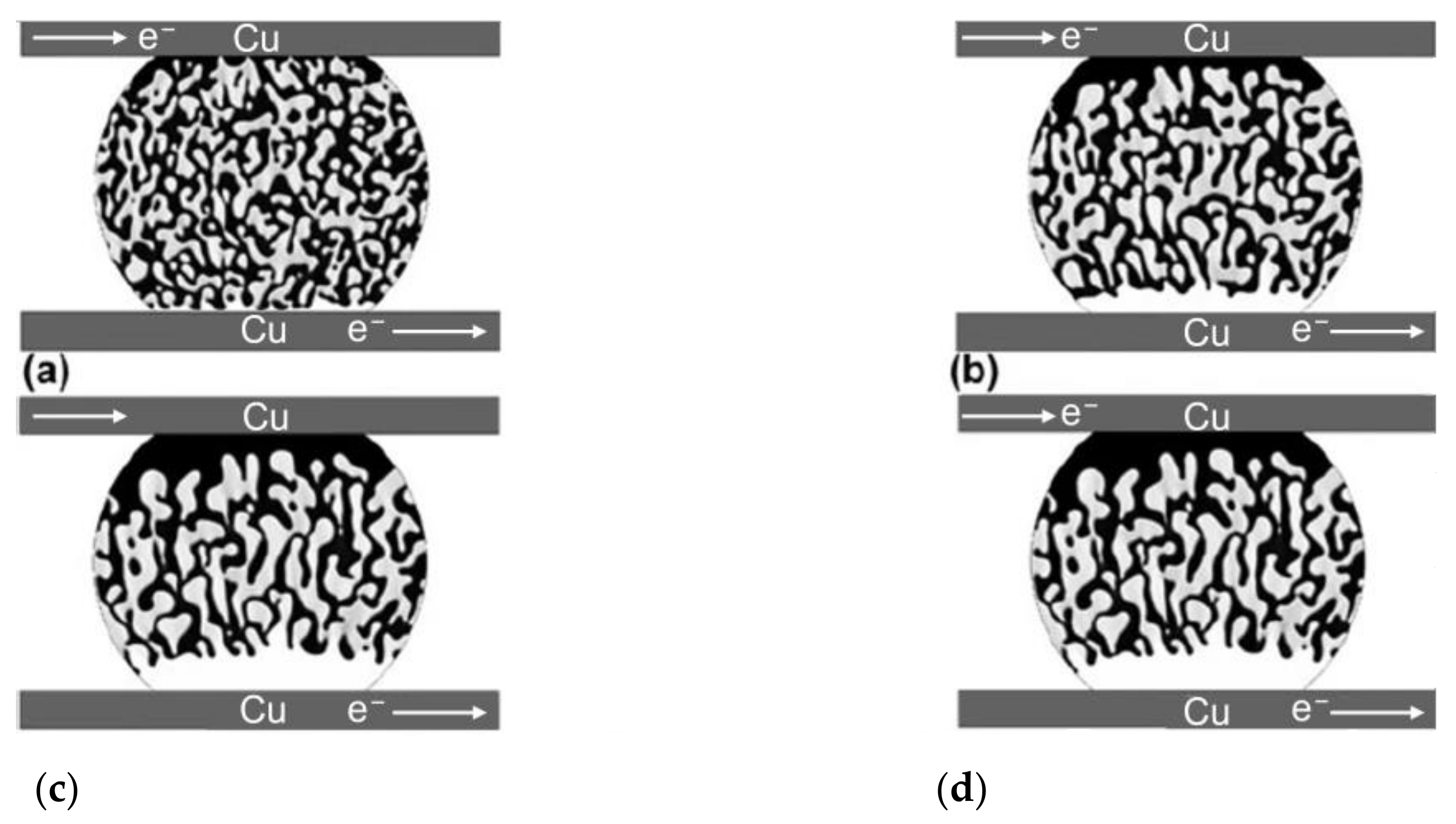

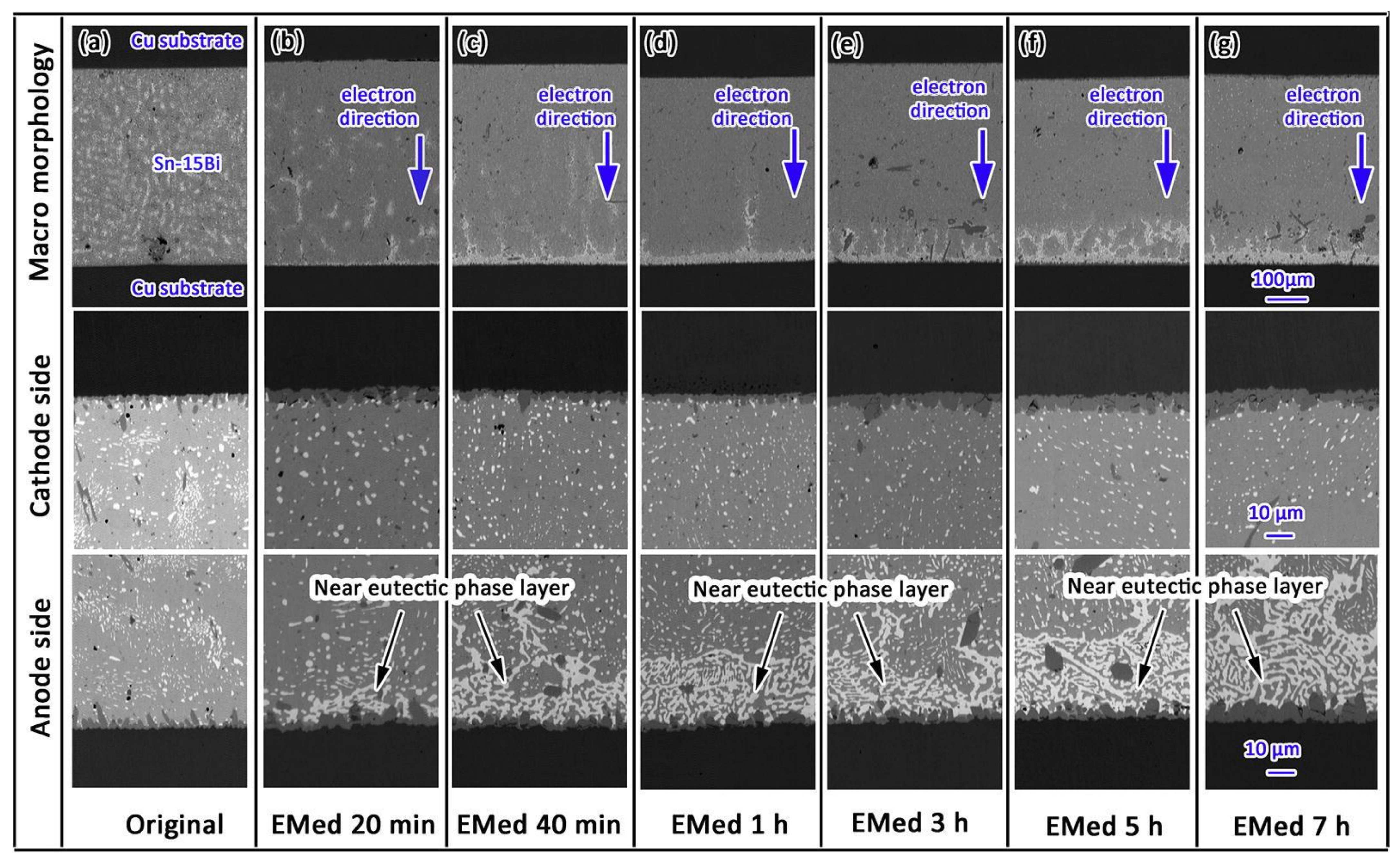
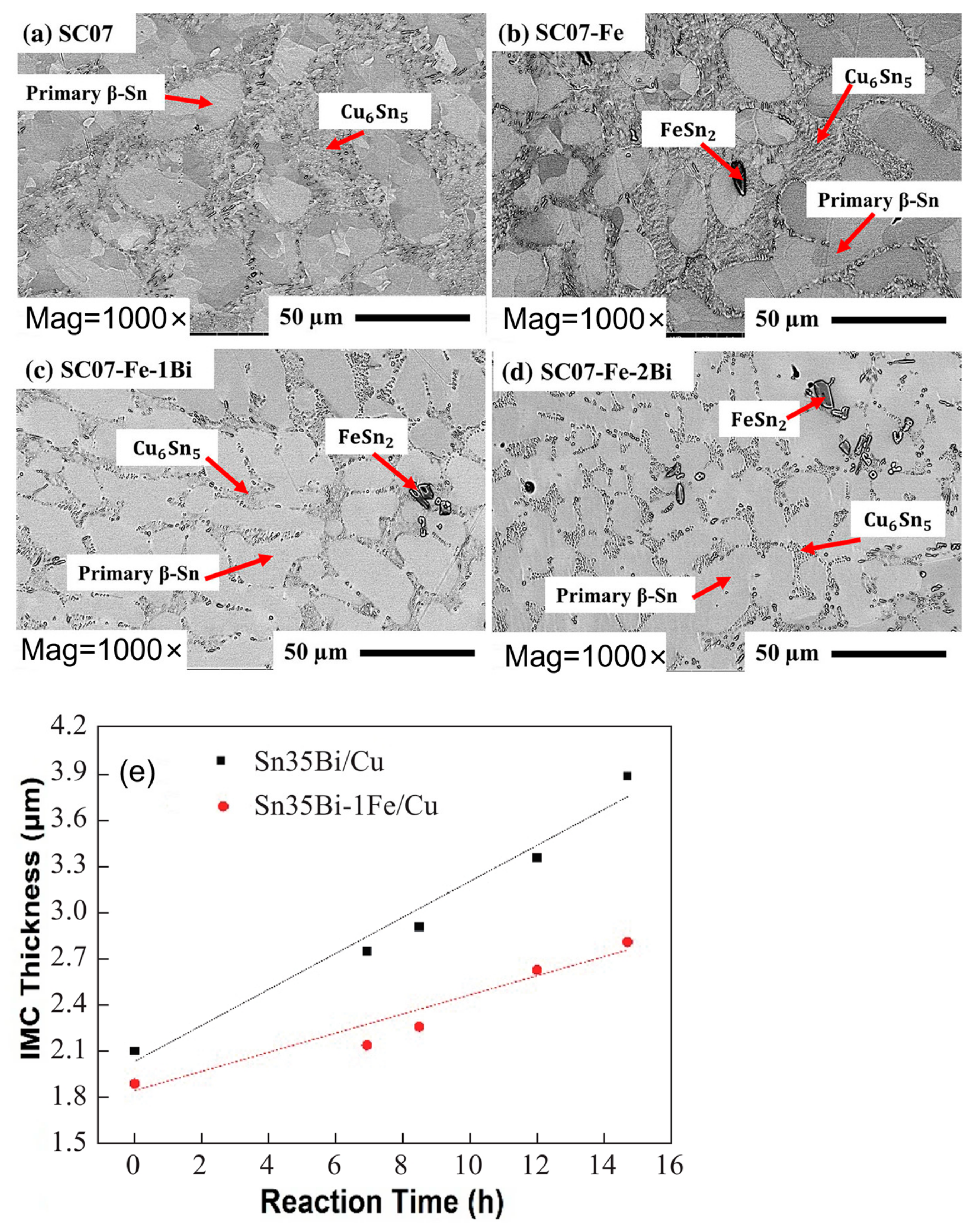
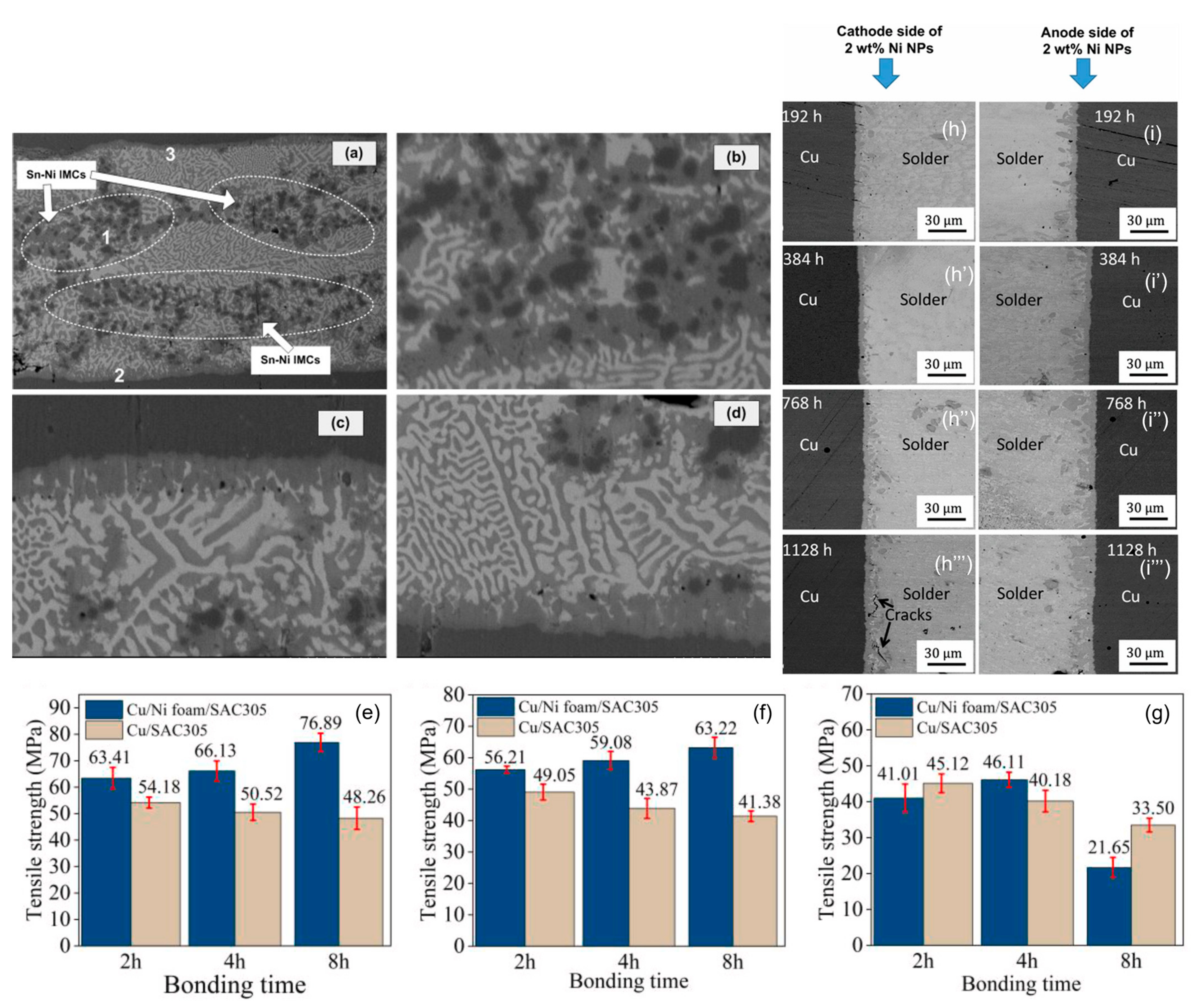
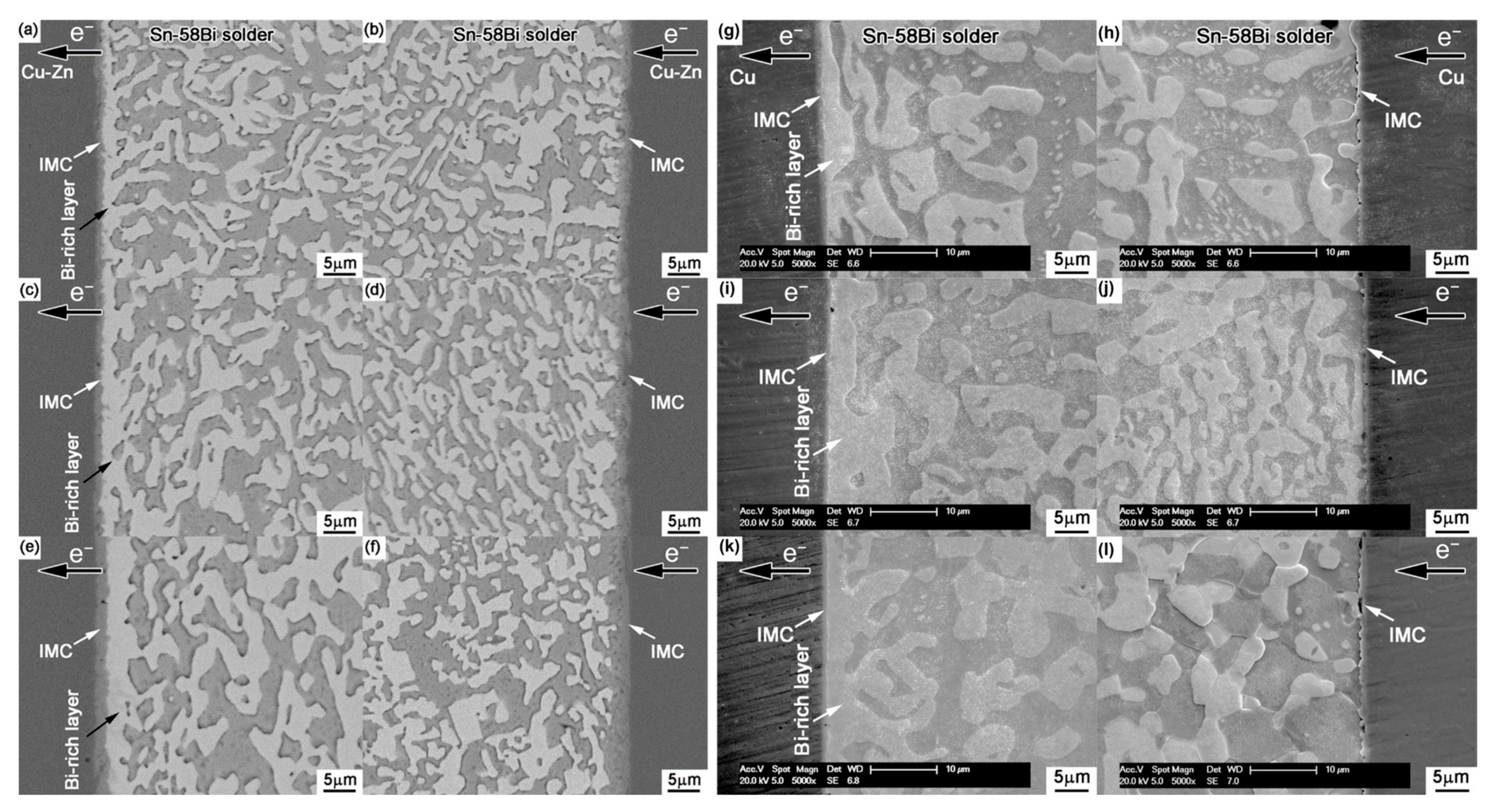

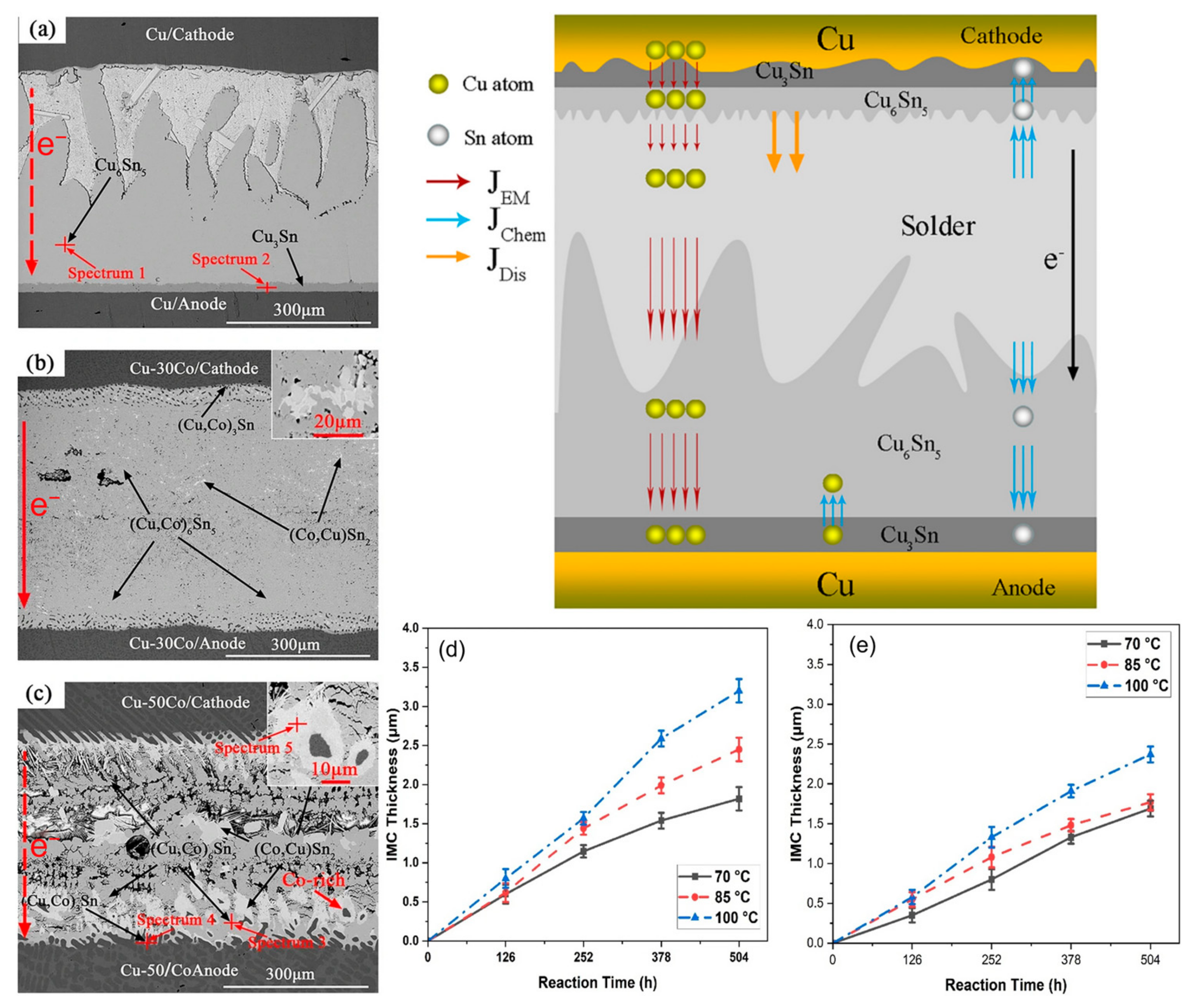
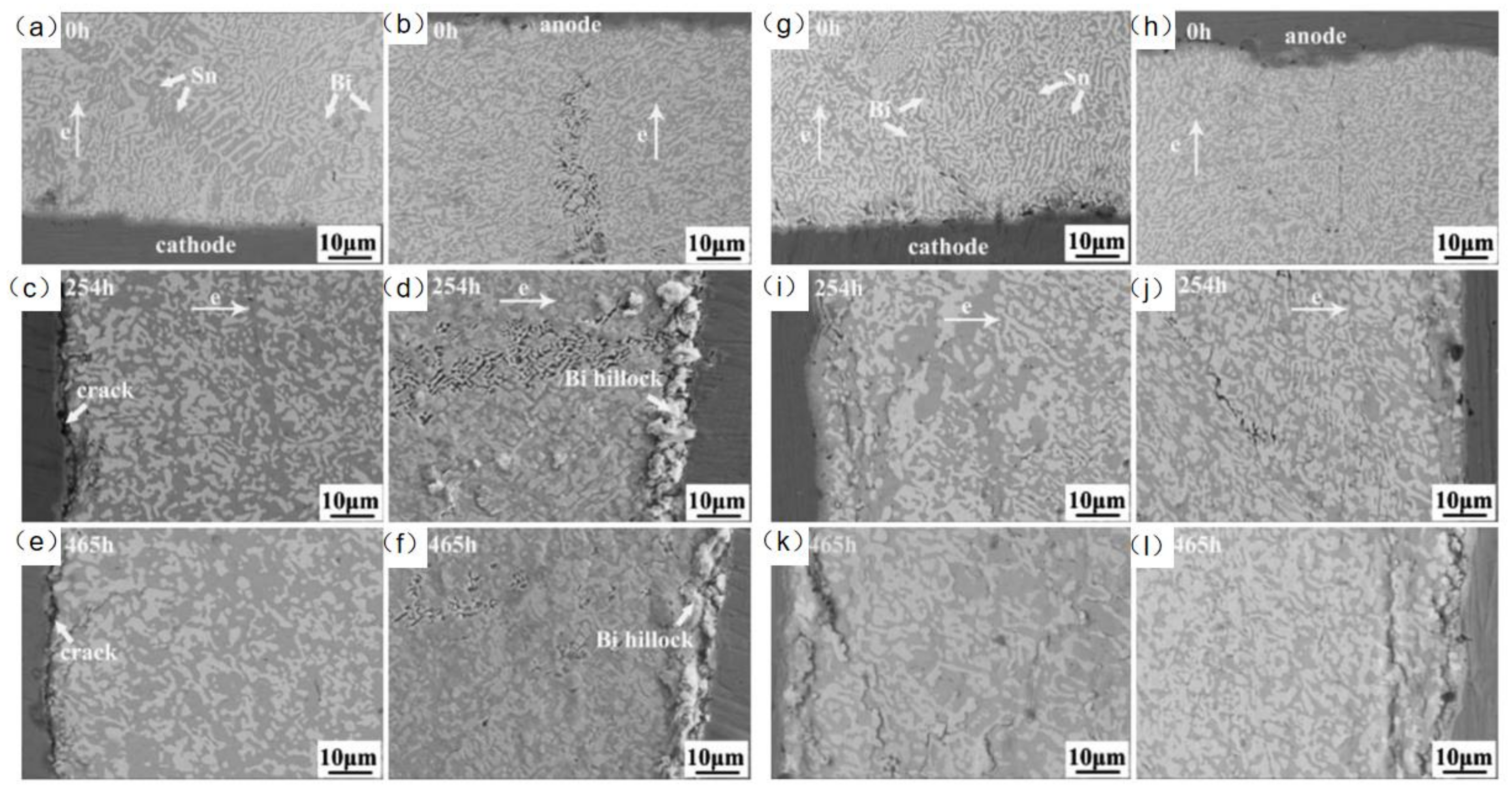


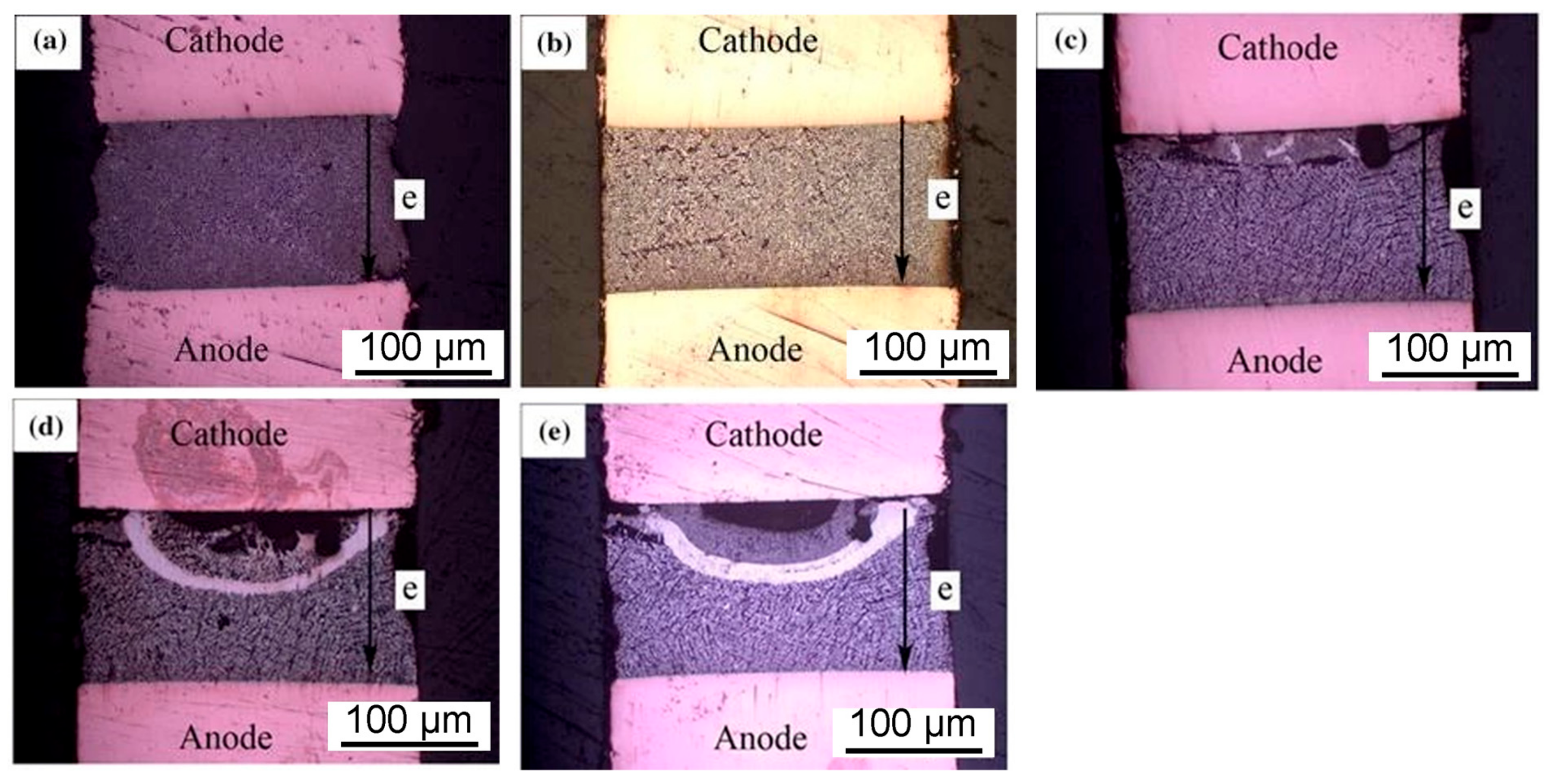
| Additive | Solder | Methods for Improving Electromigration | Reference |
|---|---|---|---|
| Fe | SnBi | FeSn2, Fe2O3 hinder atomic diffusion | [56,57,58,59,60] |
| Ni | SnBi | The formation of compound (Cu, Ni)6Sn5 hinders atomic migration | [68,69,70,71,72,73] |
| Ag | SnBi | The formation of compound Ag3Sn obstructs atomic migration and refines grain | [79,80,81,82,83,84,85,86,87,88] |
| Zn | SnBi | Zn diffuses in the opposite direction to the main migratory material, hindering migration | [92,93,94] |
| Co | SnBi | Form a large amount of (Co, Cu)Sn2, barrier material migration | [96,97] |
| RE | SnBi | Rare earth elements accumulate towards the grain boundaries, blocking the transport of atoms | [103,104,105,106,107] |
| GNSs | SnBi | GNSs blocks atomic migration | [111,112] |
| FNSs | SnAgCu | The FNSs particles become a barrier, preventing atomic migration | [113,114,115] |
| Al2O3 | SnBi | Al2O3 prevents atomic migration | [116,117,118,119,120,121] |
| Improved Technology | Solder | Methods for Improving Electromigration | Reference |
|---|---|---|---|
| Orientation change | SnBi | Large grain boundaries hinder the diffusion of atoms | [122,123,124,125] |
| Stress application | SnBi | Add stress to increase the vacancy in the weld and reduce the migration speed of Bi | [126] |
Disclaimer/Publisher’s Note: The statements, opinions and data contained in all publications are solely those of the individual author(s) and contributor(s) and not of MDPI and/or the editor(s). MDPI and/or the editor(s) disclaim responsibility for any injury to people or property resulting from any ideas, methods, instructions or products referred to in the content. |
© 2024 by the authors. Licensee MDPI, Basel, Switzerland. This article is an open access article distributed under the terms and conditions of the Creative Commons Attribution (CC BY) license (https://creativecommons.org/licenses/by/4.0/).
Share and Cite
Li, W.; Guo, L.; Li, D.; Liu, Z.-Q. Research Overview on the Electromigration Reliability of SnBi Solder Alloy. Materials 2024, 17, 2848. https://doi.org/10.3390/ma17122848
Li W, Guo L, Li D, Liu Z-Q. Research Overview on the Electromigration Reliability of SnBi Solder Alloy. Materials. 2024; 17(12):2848. https://doi.org/10.3390/ma17122848
Chicago/Turabian StyleLi, Wenjie, Liwei Guo, Dan Li, and Zhi-Quan Liu. 2024. "Research Overview on the Electromigration Reliability of SnBi Solder Alloy" Materials 17, no. 12: 2848. https://doi.org/10.3390/ma17122848
APA StyleLi, W., Guo, L., Li, D., & Liu, Z.-Q. (2024). Research Overview on the Electromigration Reliability of SnBi Solder Alloy. Materials, 17(12), 2848. https://doi.org/10.3390/ma17122848






